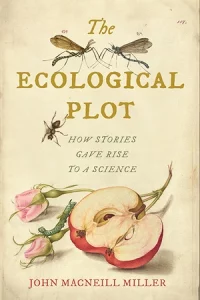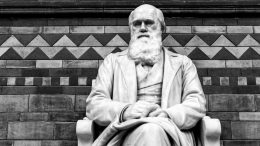Adapted from the book The Ecological Plot: How Stories Gave Rise to a Science (University of Virginia Press, Sept. 24, 2024)
There’s not much to see on a heath.
These landscapes, which once covered more than 11,000 square miles of Great Britain and northwest Europe, are all but featureless. Trees do not grow there. The only vegetation that thrives on heathland is a squat, monotonous cloak of prickly gorse and heather shrubs, occasionally interrupted by the odd holly bush or clump of ferns. Some wildlife inhabit these deserted places, but they are typically scattered widely or hidden beneath the shrubs. Heaths aren’t known for stunning cliffs, mountains, or rock formations, either. Typically their terrain ranges from relatively flat land to gently rolling hills. The effect is anything but picturesque: Heathlands leave no place for the eye to rest, no pleasing contrasts for it to explore, no sense of action at all.
 Unattractive and agriculturally infertile, heaths were the original wastelands. The novelist Thomas Hardy, who was born at the edge of a heath in southwest England, understood such landscapes as deeply and essentially inhuman, emblems of primordial nature untouched by civilization. In The Return of the Native (1878), his novel about an impoverished community situated on the fictional Egdon Heath, Hardy described heathland as a relic of what the earth looked like before the rise of human agriculture — and what it would return to after our extinction. It was a “great inviolate place” that “had been from prehistoric times as unaltered as the stars overhead.” The attention Hardy lavished on Egdon Heath and other British terrain would help establish his reputation as a “landscape novelist,” in the words of one early admirer, a writer whose works cultivate the kind of admiration for natural landscapes that provides the foundation of ecological attachment.
Unattractive and agriculturally infertile, heaths were the original wastelands. The novelist Thomas Hardy, who was born at the edge of a heath in southwest England, understood such landscapes as deeply and essentially inhuman, emblems of primordial nature untouched by civilization. In The Return of the Native (1878), his novel about an impoverished community situated on the fictional Egdon Heath, Hardy described heathland as a relic of what the earth looked like before the rise of human agriculture — and what it would return to after our extinction. It was a “great inviolate place” that “had been from prehistoric times as unaltered as the stars overhead.” The attention Hardy lavished on Egdon Heath and other British terrain would help establish his reputation as a “landscape novelist,” in the words of one early admirer, a writer whose works cultivate the kind of admiration for natural landscapes that provides the foundation of ecological attachment.
A century and a half later, Hardy’s Egdon Heath has lost none of its dark, primordial power. As it turned out, however, he was utterly wrong about the ancient, enduring permanence of heathland ecosystems. Over the course of the 20th century, Britain’s lowland heaths all but vanished, dwindling in size to 14% of the acreage they covered in the 1800s. The elemental, featureless stability that entranced Hardy and his readers turned out to be an illusion. Some heaths succumbed to predictable forces of modernization, development, and urban sprawl. But others mysteriously sprouted trees and became woodlands, seemingly without human intervention whatsoever. Whatever the causes of their disappearance, the dwindling of English heathland has left the creatures that once flourished unrecognized in these eerily empty landscapes — animals like the Dartford warbler, the red-backed shrike, the sand lizard, and the slow worm — in danger of being extirpated from the country entirely.
To get the full story behind English heathlands, it’s necessary to close the book on Hardy’s magnificent but misleading fictions and turn instead to the work of someone who is not widely considered a storyteller at all: Charles Darwin. Darwin wrote about his encounters with heaths in On the Origin of Species (1859), the book that famously laid out his theory of natural selection and charted the course for modern biology. But the Origin was equally vital to the rise of ecology. Darwin’s writings about heathlands highlight both his pivotal place in the history of ecology and the foundational role of storytelling to the science. What Darwin saw on these depopulated landscapes — and what Hardy could not see, for all his intimacy with them — had little to do with scientific training and everything to do with the different narrative forms these writers used to tell their stories about the natural world.
Darwin’s first impressions of heathland closely resembled Hardy’s. Rambling through a vast heath on a relative’s estate, Darwin was stunned by the overwhelming sameness of everything he saw. Like Hardy, he noted the feeling of barren endurance that seemed to characterize the landscape around him. The only relief from the land’s oppressive, featureless monotony occurred in a few fenced-in areas, where Darwin saw that the landowners had successfully planted pine trees and established thriving woodlots on the otherwise infertile heathland soil. The trees in these miniature forests had flourished, utterly transforming the communities of plants and animals around them. Darwin didn’t reflect much on the observation, however, until he found himself on another heath — and noticed a similar phenomenon beginning to unfold there.
Struck by the coincidence, Darwin took a closer look at some of the more recently created enclosures — and he saw something odd. The pines were fenced off for protection, but they were growing in chaotic clusters. This overcrowded approach to planting meant that few of the evergreens would survive to become harvestable timber. No competent forester would design a plantation in such a fashion. Suddenly it hit him: The trees in the younger enclosures must not have been planted after all. They had grown up on their own, somehow finding a foothold in a landscape that appeared incapable of sustaining plants taller than a holly bush.
Darwin had a mystery on his hands. If these trees weren’t evidence of the work of a forester, where had they come from? And how had they managed to survive in a landscape so obviously hostile to their growth?
Darwin — an avid fiction reader who once wrote “I often bless all novelists” — began to suspect that there was a story hidden in the landscape. He just had to learn how to read it. Assuming that a wider view would show him some previously unobserved nearby woodland or timber plantation that could explain the source of the seeds, the naturalist began scrambling up every local hillock and scanning the horizon. He was disappointed: “I went to several points of view, whence I could examine hundreds of acres of the unenclosed heath, and literally I could not see a single Scotch fir, except the old planted clumps.”
If the area around him was trying to tell a story, it suffered from an obvious plot hole. Trees don’t spontaneously sprout in the middle of landscapes that can’t support them. The place made no sense. Baffled by the implausibility of it all, Darwin did something remarkable: He literally pulled the place apart. Bending down, Darwin parted the thick stalks of heather and gorse that surrounded him like a shallow sea. There, beneath the superficial stasis and monotony of the landscape, he was astonished to discover a plenitude of tiny pine trees. These pines, he realized, were trying to grow all across the heathland.
As a Victorian naturalist, Darwin had none of the shyness of later scientists when it came to personifying other beings. Seeing the young pines, he recognized that they were crucial characters in the story this scenery was hiding. He treated the trees accordingly, understanding each plant as a distinct individual striving toward the goal of a flourishing life. “In one square yard,” he wrote, “I counted thirty-two little trees; and one of them, with twenty-six rings of growth, had during many years tried to raise its head above the stems of the heath, and had failed.”
Bestowing this kind of interest on each tree raised yet another question of plotting. The struggling pine’s story began when it blew over the heath as a seed, found a suitable spot to germinate, and began to sprout. Next the sapling reached up toward the sun, taking in minerals and air and water in its attempt to become a full-grown tree. There its plot halted. What happened next? Darwin wondered. Twenty-odd years went by — but the tree never got any taller. Who or what had intervened in this little tree’s once promising success story? What characters and sequences of events was Darwin missing?
This story, Darwin realized, was beyond the pale — in the original sense of the phrase. A pale or paling is simply an archaic name for a fence staked into the ground. The saplings Darwin found around his feet grew outside of any fenced-off enclosures, the first places he had been surprised to find both intentional and accidental woods springing from heathland. The fences were of simple construction; all they did was deter wandering livestock. If fences alone made the difference between heathland and pine forests, that meant livestock must be the antagonists in the sad tale of the unsuccessful sapling. Cattle were browsing on the saplings, munching them down before they could overgrow the surrounding shrubs and convert the entire heathery countryside into woodland.
The story was simple enough, but its implications were enormous. It suggested that the stable expanses of English heathlands — places that Darwin, like Hardy, first saw as “large and extremely barren” places “which had never been touched by the hand of man” — were as manmade as today’s parking lots. Without the constant disturbance of sheep, cattle, and pony populations maintained by domestication, the scattered heathlands that naturally sprouted up in the margins and clearings of woodlands would soon be overtaken by trees.
The endurance of English heathlands, then, was not some memento of nature’s inhuman, primordial power. It was a product of this landscape’s longstanding symbiosis with a species that had dominated the island of Great Britain for many thousands of years: human beings.
Hardy’s personal intimacy with heathland enabled him to see many features of heathland life that Darwin had missed. The Return of the Native includes enthralling descriptions of the many creatures that shared this unique habitat with humans — including the sheep and ponies whose wanderings of such common lands helped guarantee the heaths’ continued existence. Hardy’s novel also details the customs of human heath-dwellers who had learned how to satisfy their needs using what the local vegetation provided — cutting the shrubs and even harvesting the turf itself in the processes of producing food, firewood, and household implements. These activities magnified the disturbances to the landscape caused by grazing animals, all but ensuring that evergreens had no chance of overtaking the local scrub and converting the heath into forest.
For all his careful observation of heathland creatures and customs, however, Hardy could only see the heath as a setting: a dramatic backdrop for more compelling human fates. This vast, dark sweep of terrain remained a static place for him, a timeless environment essentially untouched and untouchable by human doings. He could not fathom that the grazing animals and the folkways he detailed so meticulously might actually make a difference — that heathland might be more than just an ominous setting for his novel’s plot. This untouchability added to the land’s fascination and majesty, but also to its horror. As Hardy saw it, the heath’s sublime size and durability only underscored the smallness of human life in the face of nature and geological time. These themes would percolate through all of Hardy’s later fiction, lending his best-known works their profoundly pessimistic tone.
It took the founder of ecology to see heathland differently. Darwin’s mind, like Hardy’s, had a strong narrative turn. But Darwin saw plot and characters unfolding not just among human beings, but among all the plants and animals around us, too. His hunger for stories enabled him to see incongruities in heath landscapes — incongruities that led him to pull the setting apart and discover the plots hidden within it. Heathland, he realized, was not a timeless backdrop. It was the ongoing appearance of a living, breathing community, the product of a fragile balance of power between heather, gorse, trees, and human beings. When that balance was upset — either by the obvious activity of bulldozers and asphalt or by more subtle shifts in agriculture and the change of ancient folkways — the seemingly timeless, unchanging heath could not survive.
Less than a decade after Darwin published Origin, the German naturalist Ernst Haeckel recognized that Darwin’s stories of interspecies communities constituted a subject so innovative it deserved a new name. He coined the word Oekologie to describe it. We now think of ecology as a science, a field whose rigor and objectivity separate it from the more personal, fanciful, and emotionally charged kinds of writing found in literature.
Returning to the roots of ecological science helps remind us that it, too, started as a way of reading the stories embedded throughout the world around us. The history of English heaths shows how treating nature as a collection of environments, places, or landscapes — as Hardy did — risks obscuring the complex, mutually dependent relationships of human beings to other lifeforms. The result is a misunderstanding of both the land and of our crucial role in maintaining it.
What Darwin practiced, then, was not simply an early form of ecology but an early form of ecological literacy. That literacy was not just a metaphor for a more scientific understanding of natural systems — it was an actual art of reading, interpreting, and sharing the stories nature told. Darwin’s ecological literacy involved extending aims and desires to animals and even plants, a habit that might be dismissed as unscientific anthropomorphism today. Nevertheless, it helped Darwin recognize that humans are not the main characters treading earth like an empty stage. We are part of a much larger ensemble cast. Darwin’s work refused simplistic divides between the arts and sciences. If we do the same, we can come to a clear sense of the stories nature tells us — and make better decisions about the parts we need to play to keep the tale of our time on this planet from turning into a tragedy.
Previously in The Revelator:
Why Climate Grief Is an Essential for Climate Action




